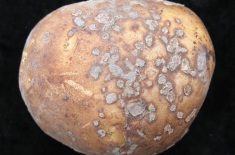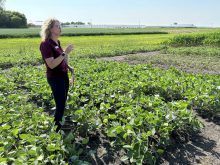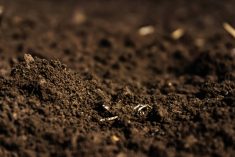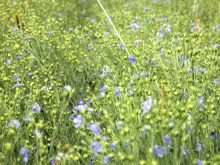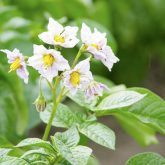After a couple of challenging wet seasons, the spring of 2012 looked like it was off to a good start.
Dry, workable soils led to one of the earliest planting completions in the history of the potato business in Manitoba, and growers were looking forward to a successful season.
However, that planting season was only made possible by a dry fall, and lower-than-average snowfall that winter, Keystone Potato Producers Association extension agronomist Andrew Ronald told growers at the 2013 Manitoba Potato Production days.
It set up a challenging irrigation season, with growers fighting to keep up with water demand as dry conditions and blazing heat took water away from the fields.
Read Also

Manitoba canola industry has new frontiers
Canola oil is still the main priority for the sector, but canola meal is increasingly the subject of research looking for new markets and uses for the oilseed’s byproduct.
“Twenty inches of rainfall equivalent was lost to evapo-transpiration, compared to 13-14 inches the previous year,” Ronald told growers. “This wasn’t a year you had a chance to catch up.”
John Goff, of Corduroy Plains Farm near Carman, said it was a season to open the taps and keep them running — something that was a bit of a challenge when you’ve got 13 circles and only 10 pivots.
“That was definitely a challenge, but we got pretty good at it,” he said with a chuckle. “We had it down to an hour and 45 minutes from turning the water off to turning the water on.”
Ronald said that as growers struggled to get enough water onto their crops, the heat really got turned up. Too high, actually. In the first half of July, about two-thirds of the daily highs were above 30 C, and even into August temperatures remained unseasonably high.
“Potatoes are no corn crop,” Ronald said. “They prefer to not be always under the heat lamp.”
That’s why heat units — which were about 250 units above normal for the season — are such a poor measure for potato growth, since the crop grows best when temperatures are between 7 and 30 C.
“We had all the wrong kind of heat — the extreme heat,” Ronald said.
It also fell at the wrong time of year, during the tuber set and initiation stage, then continuing on through the tuber bulking period. It definitely had an impact on the potatoes coming out of the field this past fall.
“The tubers, especially the Russet Burbank, were longer and skinnier — those more stressed shapes,” Ronald said.
Growers grappled with water constraints. Growers relying on retention ponds for irrigation were disappointed by the limited snowfall, which mean limited water during the growing season.
Wayne Derkson, of Hespler Farms near Winkler, shares a reservoir co-owned with neighbouring growers and operated in season by a hired manager. It has a capacity of 450 acre-feet.
“In 2012, we just ran out of water,” Derksen said. “I would have loved to do at least one more inch.”
Back in Carman, John Goff was able to irrigate most of his fields all year, since he only has one reservoir system, with the rest of the water coming from the Boyne River. And while there was some nervous chatter about limiting flows from the Lake Stephenfield reservoir, the 10-cubic-foot-per-second flow was largely unaltered all season and he and other irrigators on the river worked together to ensure adequate water supply.
“It’s a great group of guys on the river, and I think we work together really well,” Goff said. “We didn’t shut the water off from the end of June.”
Andrew Ronald said the quality question essentially boiled down to who had the capacity and systems in place. Where growers put the water on early, and weren’t forced to shut down early because of supply constraints, the crop was good quality.
“There were lots of Russet Burbank where we were able to do what we needed to with water,” he said.
It has made for some storage challenges, though, with plenty of examples of jelly end rot, stem end rot, low solids and high sugars.
There were also more runners and sprouts than usual, which limited tuber set and affected yield, as well as tuber chaining which sees small, secondary potatoes form beyond the primary tuber and compete for resources and limit bulking.
Gary Sloik, KPPA manager, recently wrote in the Spudsmart publication that the marked quality and yield differences is likely to cause growers to shift their irrigation and drainage focus a bit.
“As producers’ thoughts have strayed towards drainage and tile drainage during the past few winters, we fully expect increased irrigation will be a major focus for the winter of 2012-13,” he wrote.







